Stracenate, Stracnar and a Cavarola Board
“…This is another of those great old pastas that must be made manually and is disappearing, but let us revive it…”
– Giuliano Bugialli, in Bugialli on Pasta
Everything old is new again. No jive. Question: What’s a cavarola? Answer: a small rectangular wooden board with a herringbone surface used to make some of the traditional pastas of Italy’s Mezzogiorno. These household boards are relatively small, usually about 12 inches long and 8 inches wide. They can be made from any wood – fruit woods and beech being very commonly used. The herringbone pattern is carved into one side of the board, and is transferred to the pasta with a rolling pin. The resulting pasta is unique, lovely to look at and the irregular surface holds condimenti better than any smooth pasta ever could.
It is with warm thanks and much admiration that I congratulate Terry Mirri of Artisanal Pasta Tools in Sonoma, California for his participation in the burgeoning revival of several little known tools for creating these old pastas – pastas that require more than your hand to make. I hope this post sparks your interest in handmade pasta tools. These boards are rarely seen in culinary supply stores, even Italian specialty shops, but Terry has stepped in to fill the void. He will make a board for you from beech, walnut or cherry. His woodwork is infused with his passion and deep abiding respect for his Italian heritage. His boards are beautiful and will be passed from generation to generation in your family.

“…Di pasta simile son tutti quanti…”
“…They are all made of the same dough…” – Despina, Cosi fan tutte
by Wolfgang Amadeus Mozart, libretto by Lorenzo Da Ponte
Mozart’s Despina was talking about men, but the same is true of pasta. And I am not kidding.
 There are five ingredients: grain, most often wheat flour, any one of several varieties from hard to soft wheat, milled to varying degrees of fineness, and refined to different levels of protein and fiber content; eggs – maybe yes, maybe no; water, maybe yes, maybe no; fat in the form of olive oil or lard, maybe yes, maybe no; salt, maybe yes, maybe no. All you need is a grain or cereal and something to wet it. And that is it. And, I am not trying to be funny here, you can even dispense with the wheat or cereal altogether and go for potatoes. But my point is that of all the foodstuffs in our world, none is so varied while derived from essentially the same, very short list of ingredients. You can immerse yourself in handmade pastas, and never, I mean NEVER, make the entire panoply. You can make abbotta pezziende, abissini, alfabeto, alisanzas, anellletti (anellini) and avemarie. And that is just some of the a’s. But first, you gotta make dough.
There are five ingredients: grain, most often wheat flour, any one of several varieties from hard to soft wheat, milled to varying degrees of fineness, and refined to different levels of protein and fiber content; eggs – maybe yes, maybe no; water, maybe yes, maybe no; fat in the form of olive oil or lard, maybe yes, maybe no; salt, maybe yes, maybe no. All you need is a grain or cereal and something to wet it. And that is it. And, I am not trying to be funny here, you can even dispense with the wheat or cereal altogether and go for potatoes. But my point is that of all the foodstuffs in our world, none is so varied while derived from essentially the same, very short list of ingredients. You can immerse yourself in handmade pastas, and never, I mean NEVER, make the entire panoply. You can make abbotta pezziende, abissini, alfabeto, alisanzas, anellletti (anellini) and avemarie. And that is just some of the a’s. But first, you gotta make dough.
Let us begin with stracenate. Let me note that as always, regional differences come into play. In Puglia, land of Trulli houses and home to the finest wheat and most magnificent bread in all of Italy, these rectangular strips of embossed pasta are known as stracenate, while in tiny neighboring Lucania the name is stracnar. Don’t let it throw you. This is Italy. Different name. Same pasta. Gotta keep up with me here. Stracnar and stracenate are united in ingredients and method of preparation. A luxurious egg dough, enriched with semolina, is rolled into flat sheets, cut into rectangles, placed on the well floured cavarola board, and embossed with a rolling pin. Or embossed first and cut later. Hey, like I said, it’s Italy. With a simple sauce of tomato and a Fontanavigna Pallagrello Bianco this unique pastasciutta is certain to get the dinner conversation going.
I use a dough recipe from Giuliano Bugialli and it is with great respect I direct you to his volume Bugialli on Pasta. If you purchase only one book on pasta, let this be it. Sig. Bugialli himself deserves to undergo a revival, and I am pleased to be the first to call for a Bugialli Rinascimento. Check him out on YouTube – he is a must for any serious student of Italian food. But let us return to the dough; Sig. Bugialli calls for 5 extra large eggs. I have made his dough with large and extra large eggs, and I have achieved excellent results with both. I bring this up only because most of us keep large eggs in our refrigerators, and are put off by recipes that call for anything else. Use large eggs. Don’t worry. Your dough will be great.
One place, however, where you can neither skimp nor substitute is with the two flours, all-purpose and semolina in a 2 to 1 ratio. Puglia is the Kingdom of Grano Duro, high gluten wheat – semolina. Hectare upon hectare of it – Pugliese farmers produce millions of tons of this high protein wheat (14% to 16%) yearly, and in fact Puglia is known as The Breadbasket of Italy. Milled once, the grain is used in both dry and fresh pasta making, milled several times – almost to talc, the semolina is used to make some of Italy’s most famous bread. You can find semolina for pasta making at every Italian market and many supermarkets. If you can not find it at a store near you, go to Amazon.com.
Stracenate Pomodorini
How to Make Stracenate
Dough
2 cups all-purpose flour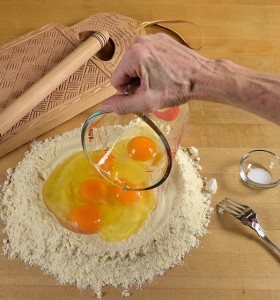
1 cup semolina
generous pinch kosher salt
5 large eggs
Hand Method
Place flour on work surface. Place flours on spianatoia (work board) and make a fontana (well) in the center by hollowing out a spot about the size of an orange. Place eggs and salt in the fontana, and using a fork, agitate to mix. With each stroke of the fork, bring a bit of flour into the mix, being careful to maintain the integrity of the fontana by moving your free hand around the outside of it and shoring up the sides until all the flour is mixed with the eggs. You may have to add more flour if the dough is too wet or a bit of water if it is too dry. Once all the flour is incorporated and the dough has come together in a large mass, set it aside, and using a bench scraper, clean work surface. Scatter just a bit of flour over the work surface and knead dough for about 5 minutes, until it is smooth, elastic and just barely sticky. Wrap dough in plastic and allow it to rest 30 minutes.
Processor Method
Place flours and salt in workbowl of food processor fitted with steel blade. Pulse twice to combine. Place eggs in a measuring cup and use a fork to lightly mix. With processor running, add eggs in a steady stream until dough comes together, about 30 seconds. Check to see if dough is too wet or too dry, adding flour or water if needed. Remove dough from processor and knead about 1 minute. Wrap in plastic and allow it to rest 30 minutes.
To form the Stracenate
Cover a tray with a lint free towel. Dust towel and board with flour. Roll dough by hand or to setting #5 on a pasta machine.
Cut dough into rectangles 3/4 inch wide and 2 1/4 inch long.
Place each piece of dough on cavarola board and use a rolling pin to gently emboss. OR emboss a large piece of dough first and cut it into rectangles after embossing. Click here to see Terri of Artisanal Pasta Tools demonstrate the second method. After watching me at work, Bart also suggested the second method. Leave it to the guys to figure out the smartest use of time! Place on towel lined trays until ready to use.
Condimento
1 red onion, chopped
2 cloves garlic, minced
1 pound small cherry or pear tomatoes, halved
1/4 cup olive oil
handful of basil – about 1 cup of leaves, cut into julienne
1/2 teaspoon oregano or q.b.
red pepper flakes q.b.
salt and pepper
Parmigiano Reggiano or Grana Padano for grating at service
Pour olive oil in hot saute pan. Add red onion and a generous pinch of kosher salt and cook over medium heat, stirring to prevent browning until onion has softened and is translucent, about 5 to 7 minutes. Add garlic and cook until fragrant, about 2 to 3 minutes. Add tomatoes, oregano and red pepper flakes. For this condimento the tomatoes must remain intact; with heat remaining at medium, cook, stirring frequently but gently, until tomatoes are lightly cooked and softened, about 8 to10 minutes. Transfer cooked pasta to saute pan and stir to coat, adding pasta water to loosen sauce, if necessary. Add basil, toss and transfer to warm serving platter. Top with grated cheese, and serve at once.
Variation: This condimento is also wonderful with spicy pork sausage. To use: remove sausage from casing, and add to the saute pan just after garlic becomes fragrant. Add oregano and red pepper flakes. Break sausage up, and brown completely. Add tomatoes and proceed as directed as above.
Note: You can click on any picture to see a slide show with even more pictures!
I have no affiliation with any product, manufacturer, or site mentioned in this article.

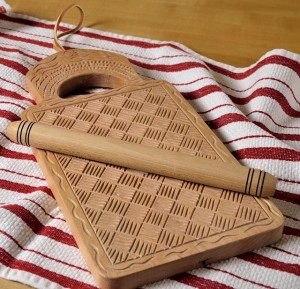


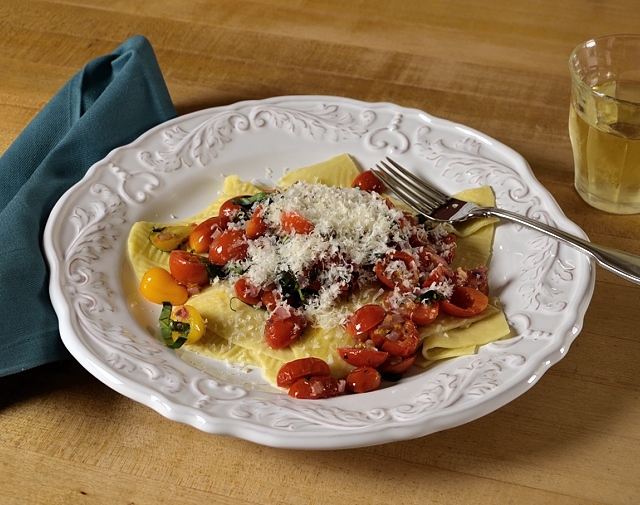
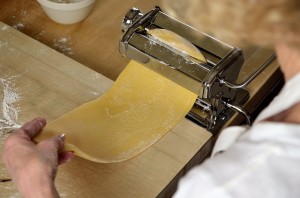
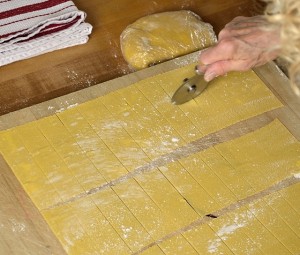

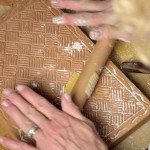

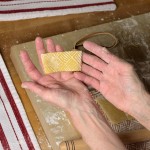
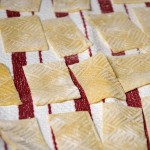
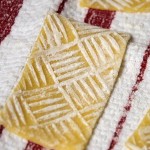

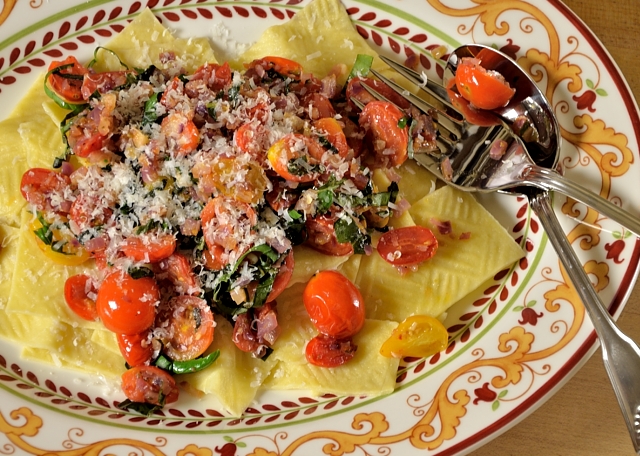
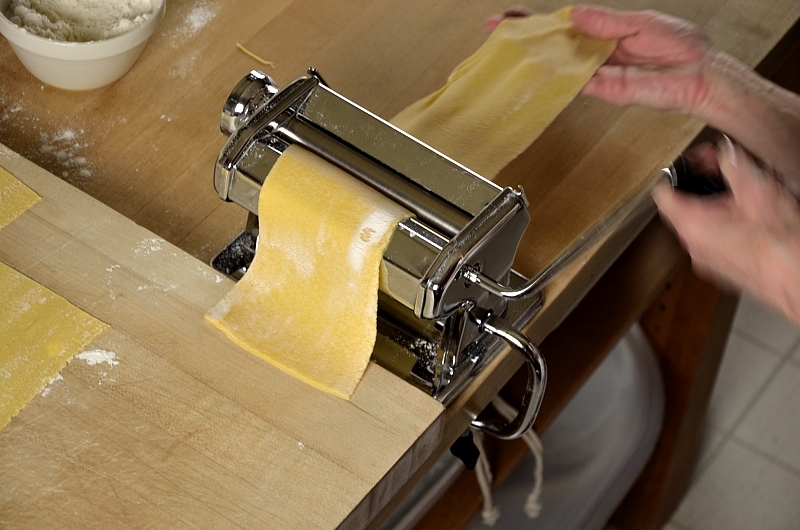

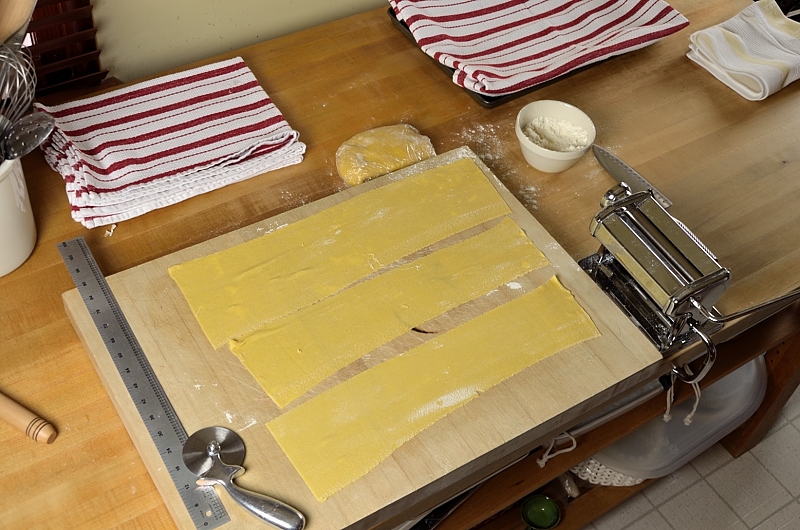

Saturday, July 23rd 2011 at 7:10 pm |
I never heard of this pasta before, and I am so glad you are bringing this back to life! One more thing to look for on my next trip to southern Italy. The tool is beautiful indeed. My grandmother from Abruzzo used to make “quadretti” which were essentially squares of egg pasta as you cut in this post, but without the engraving. I always love the extra texture Of engraved pasta, just like with croxetti.
Saturday, July 23rd 2011 at 7:35 pm |
I enjoyed learning about this, and the tool is beautiful indeed. I have developed a special fondness for the various engraved pastas. Ah, but your grandmother is Abruzzese – I am half Abruzzese – on my father’s side! My grandfather was born in Montesilvano, near Pescara. Of course, when we think of Abruzzo, we think of maccheroni alla chitarra – always fun to make, most especially if guests are in the kitchen. But I am not familiar with quadretti. Isn’t this wonderful – learning about all of these things that are new to us?
Sunday, July 24th 2011 at 4:32 pm |
Oh I think I will have to get one of these boards. I never heard of these, but am totally smitten.
Sunday, July 24th 2011 at 10:34 pm |
Hi there,
I am glad you like it. Don’t you love seeing new culinary tools? These boards are beautiful, and the pasta is so unique. You will love it. Thanks for stopping by my site!
Monday, July 25th 2011 at 12:23 pm |
Excellent post! I have been very tempted by Terri’s lovely boards. 🙂
Monday, July 25th 2011 at 6:24 pm |
It’s great to hear from you – I hope all is well. Terry’s boards really are beautiful, made more so by his deep respect for the Italian tradition. The pasta is gorgeous, and with this very rich egg dough, it is just divine. Let me hear from you when you get yours. I’d love to see what you come up with!
Monday, July 25th 2011 at 3:29 pm |
Hi, Adri,
Another great recipe! I loved seeing your hands and a bit of your hair, but missed the pearls. At what point to you add the basil? How much? Lynne
Monday, July 25th 2011 at 6:30 pm |
Thanks for the kind words – I am so accustomed to throwing basil into everything this time of year, I neglected to write about it! Grab a handful – about 1 cup of leaves, chop or julienne them, and toss them into the saute pan just after the pasta to finish the dish. I am so glad you liked this post. I am having a ball with these handmade pastas. You could make a new one every day and never get through all of them. And the pearls are still there!
Tuesday, July 26th 2011 at 9:41 am |
I am glad to hear you learned from this post. I’ve heard that from many readers, and it is gratifying to hear that I can help enlighten people as to these traditional Italian pastas.
Friday, November 23rd 2012 at 6:19 am |
like to buy stracnar board
Friday, November 23rd 2012 at 7:09 am |
Hi Patsy,
Terry Mirri of Artisanal Pasta Tools in Sonoma, California sells them. You can contact him at http://www.artisanalpastatools.com where you can see the different woods he uses. When you get to his site, look at the cavarola boards You may phone him at 707-939-6474 between 9 AM and 6 PM Pacific time. Thanks so much for stopping by my site, and I hope you enjoy your board.
Saturday, August 24th 2013 at 11:59 pm |
Another amazing recipe! Excellent post…I am getting hungry looking at it! Paola
Sunday, August 25th 2013 at 6:10 am |
Ciao Paola!
Thanks so much. Thee is something so tempting about this kind of food. It seems that everyone enjoys it, and this is made all the more appealing with the stracnar, beautiful as it is.